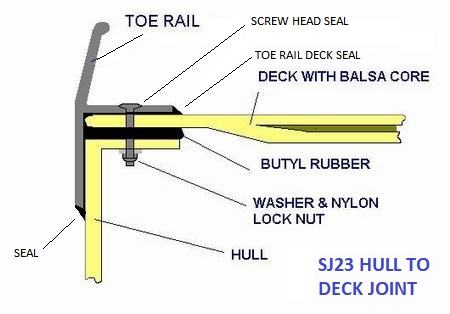| SJ23 Tech Tip J04, (Issued 2007-09-13) Bob Schimmel | |
|
Thoughts on Raising a Submerged SJ23, (perish the thought). INDEX - Outside Flotation, Ping Pong Balls, Bladder, Crane, Legalities. |
|
Now you may wonder why I would add a Tech Tip like this to the web
site. Well, if anybody needs help it is the poor soul whose boat is at
the bottom. So I'm offering some suggestions.
A fibreglass sailboat weighs less underwater than on above. I wish I could tell you the exact weight of a submerged SJ23 but my S.W.A.G. calculates it to approximately 1000 lbs. If anybody can calculate this, I'd be happy to place the "correct" answer here. I have witnessed a few recoveries and all of them required different techniques based on the situation; boat size, construction & condition, water depth, clarity & current, surface weather and finally debris on the bottom. These are the main issues to take into consideration. There are two times during a recovery that are very dangerous: the first is when the boat is approached (lots of unknowns) and the second is just at the joyous moment when the boat starts to rise. This last one is particularly dangerous because it may be difficult to control the direction of the boat or the rate of ascent. I once watched a 35' sailboat being raised 100' in clear water. We were above it when it started to rise and barely got out of the way as it charged for the surface. It is amazing how quickly it can come up from that depth. Don't get under her and don't hang on for the ride.
If the sails are hoisted under water, lower them before the boat rises. You don't need the steering effect while being raised not do you need the wind load at the surface! Empty the boat as much as possible to eliminate complications. Remove the outboard engine. Fill the four barrels with air, each of them a little at a time, so they have equal floatation and the boat stands upright on the bottom. The boat must rise with the hull in an upright, horizontal attitude. The barrel fill hole must be at the bottom so expanding air can escape as the boat rises. Plug the holes when the boat is at the surface. Tie the plugs to the barrels, close to the fill holes. Do not climb into the boat when it is at the surface. This is a recipe for disaster. Decide now if pumping is prudent or to tow the full boat to shallow water. A submerged boat is a cumbersome object to tow. This decision is very situation dependent. Go very slowly. If there are no holes in the hull, then pumping gains you immediate security and improved control. An empty boat is very easy to tow and a great relief. It might be prudent to tow it to shallow water where you can float her permanently with less fear of doing further damage.
BLADDER - Buying enough ping pong balls to lift an SJ23 is rather expensive. Go to a sporting good store and do the math. Bladders can be substituted since they are much easier for a diver to handle. If the bladder inlets are extended to the companionway with air lines, they can be filled from a central location making the recovery work safer for the divers. The air bladders must be capable of relieving air to prevent bursting as the boat rises to the surface. This feature makes them expensive and gives you an idea of the forethought required to execute a lift. CRANE - The boats are carried along the
factory assembly line by
the shroud and backstay chain plates. So if you want to use a crane these attachment
points are strong, but not infallible. Failing that, place the slings
ahead of and behind the keel and hoist away using a compression square
above the boat to
prevent crushing the hull. Remember to tie the belly slings to each
other at the gunwales to prevent them slipping off the hull ends. Once the boat is at the surface, the water
must be pumped out before it can be lifted out of the water. If not,
the hull will break from the weight of the water, in which case the water will drain
out! |
|
|
LEGAL STUFF - There may be legal implications that prevent you from salvaging so you should contact your insurance company (or the other person's insurance company) and the proper authorities before you attempt to raise her. I've heard that the insurance company automatically owns the boat and you must pay for salvage rights to raise her. In other cases they simply want to be informed to notify the Coast Guard of a salvage operation. Then there are environmental regulations regarding fuel and oil spillage. Rules and regulations vary from one locale to another and it pays to know them in advance.
I've seen enough sailboats on the rocks or a beach but hope I never see an
SJ23 on the bottom! Good luck. |
|
|
Return to Tech Tip Index. . . . . . . . . . . . . . . Have a Question? |
|

